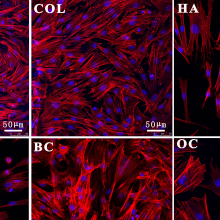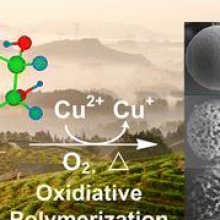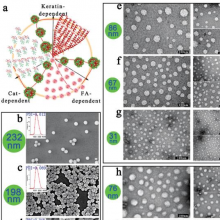已为您找到该学者13条结果 成果回收站
李旭东
ACS Biomaterials Science & Engineering,2020,6(6):3275-3286
2020年04月28日
The understanding of the mineralization of collagen for bone formation is a current key theme in bone tissue engineering and is of great relevance to the fabrication of novel biomimetic bone grafting materials. The noncollagenous proteins (NCPs) play a vital role in bone formation and are considered to be responsible for regulating intrafibrillar penetration of minerals into collagen fibrils by means of their abundant polyanionic domains. In this study, alginate, as a NCPs analogue, was introduced in the mineralization of collagen to mediate the collagen self-assembly with simultaneous hydroxyapatite (HA) synthesis. The biomimetic systems were based upon the self-assembly of collagen (Col) or collagen-alginate (CA) in the absence or presence of a varying content of HA. The alginate-mediated effects were found to include the lateral aggregation of small fibrils into the extremely large bundles and the assisted deposition of HA for a larger mineralized fibril. This alginate-assisted mineralization of collagen gave rise to an exquisite 3D mineralized architecture with enhanced mechanical property. The cell viability experiments showed the excellent proliferation and spreading morphologies of rat bone mesenchymal stem cells (MSCs) on the assembled products, and a higher expression of osteogenic differentiation related transcription factor was obtained in the alginate-assisted mineralization of collagen. This study indicated that the selection of an appropriate substance, e.g., alginate as an anionic polyelectrolyte with Ca-capturing property, could be a convenient, simple solution to achieve a mineralized collagen scaffold with the reinforced mechanical property for potential applications in bone regeneration.
Collagen, Self assembly, Alginate
-
88浏览
-
0点赞
-
0收藏
-
0分享
-
0下载
-
0
-
引用
【期刊论文】Modular Assembly of Versatile Nanoparticles with Epigallocatechin Gallate
李旭东
ACS Sustainable Chem. Eng.,2020,8(26):9833–9845
2020年06月03日
Various nanotechnologies have been extensively developed to prepare nanoparticles with different features for satisfying the requirements of diverse fields, but the current achievements are confined to different material systems for the limited acquisition with desirable properties. Here, we demonstrated a flexible strategy based on the broad selectivity of amines in the condensation of green tea polyphenol-EGCG (epigallocatechin gallate), formaldehyde, and amines for the rational design and preparation of versatile nanomaterials. With EGCG as the sole material system and amines (R–NH2) of various functional R groups as the selectable modules, the modular assembly of polyphenol-activated condensation was straightforward and completed in one step, giving rise to different polyphenolic nanoparticles variable in surface chemistry (−amine, −aldehyde, and −carboxyl), shapes (sphere, dumbbell, walnut), internal structures (solid, hollow, and porous), stimuli responsiveness (-s-s-), and fluorescence. The flexibility of the polyphenolic condensation for versatile nanoparticles was further demonstrated by the incorporation of amino-containing anticancer or antibacterial drugs into polyphenolic nanoparticles as nanodrugs. The present study totally involved the use of 13 different amines to synthesize 18 different nanoparticles, not only convincingly specifying the enormous value of the polyphenolic condensation as platform for modular assembly of versatile nanoparticles but also revolutionizing the current strategies and methodologies for encapsulated applications of tea polyphenols.
Tea polyphenol, Platform
-
58浏览
-
0点赞
-
0收藏
-
0分享
-
0下载
-
0
-
引用
Xudong Li
REGENERATIVE BIOMATERIALS,2018,5(2):93-103
2018年03月07日
Collagen (COL), collagen/hydroxyapatite (COL/HA), HA and biphasic calcium phosphate were prepared as representative bone grafting materials with composition analogous to bone, and their structural characteristics were analyzed. The rat bone mesenchymal stem cells (BMSCs) were further seeded onto four groups of materials, and BMSCs grown in basic medium and standard osteogenic medium were set as controls of a reference model to show the basic and osteogenic behavior of cells without the intervention of materials. Cellular behaviors were characterized, including proliferation, spreading morphology and expression of osteogenesis factors. The rat BMSCs proliferated properly with time on four groups of materials as well on two groups of controls, and typical cuboidal, polygonal and extremely-elongated morphologies of cells were observed. According to the real-time polymerase chain reaction data, a higher osteogenic gene expression level was dependent upon the growing morphology but not the proliferation rate of cells, and the osteogenic differentiation capacity of cells onto four groups of materials varied in specific genes. In general, BMSCs exhibited the highest osteogenic capacity onto COL/HA, but the poorest onto HA. The growing behaviors of cells on materials were further discussed in comparison with the cases of OC and BC of the reference model. The present attempt to comparatively analyze cell experimental data with a reference model is expected to be useful for revealing the difference in the osteogenic capability of MSCs onto materials or even the bioactivity of materials.
osteogenic differentiation, spreading morphology, mineralization of collagen, bioceramics
-
79浏览
-
0点赞
-
0收藏
-
0分享
-
0下载
-
0
-
引用
Xudong Li
Journal of the American Chemical Society,2013,135(11):4179-4182
2013年03月07日
Green luminescent, monodisperse, smooth, porous and hollow spheres were simply prepared by Cu2+ and temperature mediated oxidative coupling assembly of green tea polyphenols in water. These polymeric tea polyphenol spheres are GSH responsive, acid resistant but alkali-responsive, ideally used as platform for controlled delivery of functional guests.
DRUG-DELIVERY, POLYMERIZATION, ANTIOXIDANT, FLAVONOIDS
-
179浏览
-
0点赞
-
0收藏
-
0分享
-
0下载
-
0
-
引用
Xudong Li
Journal of Materials Chemistry B,2018,6(9):1373-1386
2018年01月31日
While intelligent nanoparticles with therapeutic effects provide a resolving strategy for low drug loading efficacy, poor metabolism and elimination of current nanoparticulate drug delivery systems, precise preparation of colloidally stable but stimuli-responsive nanocarriers with size tunability is still a challenging task. Here, we develop a facile and sustainable method through the use of naturally reproducible green tea polyphenols and hair keratins to prepare biocompatible, colloidally stable, stimuli-responsive nanoparticles with therapeutic effects. The present strategy simply involves covalent interactions of tea catechins and keratins, giving rise to the molecular assembly of size-controlled nanoparticles (30–230 nm) which are long-term colloidally stable at physiological media but are disassembled under pathological conditions, ideally for targeted delivery of anticancer drugs. The cell experiments confirmed that these nanoparticles are bio-safe, have the inherent bioactivity of tea catechins, and that the drug-loaded nanoparticles yield a higher cancer cell inhibition rate than free drugs. In addition, the nanoparticles are found to improve the bioavailability of tea polyphenols, according to animal studies, which further demonstrates that the use of nanoparticles as drug carriers results in enhanced anticancer efficacy with negligible systemic toxicity. Given that large-scale preparation of size-controlled nanoparticles could already be easily achieved, the present study actually provides an innovative nanotechnological approach to make good use of green tea polyphenols with beneficial health effects, potentially for therapeutic and preventive purposes.
DRUG-DELIVERY, CATECHIN DERIVATIVES, NANOTECHNOLOGY
-
176浏览
-
0点赞
-
0收藏
-
0分享
-
0下载
-
0
-
引用

 提示
提示
 恭喜!关注成功
恭喜!关注成功 期刊论文
期刊论文



 >
>
